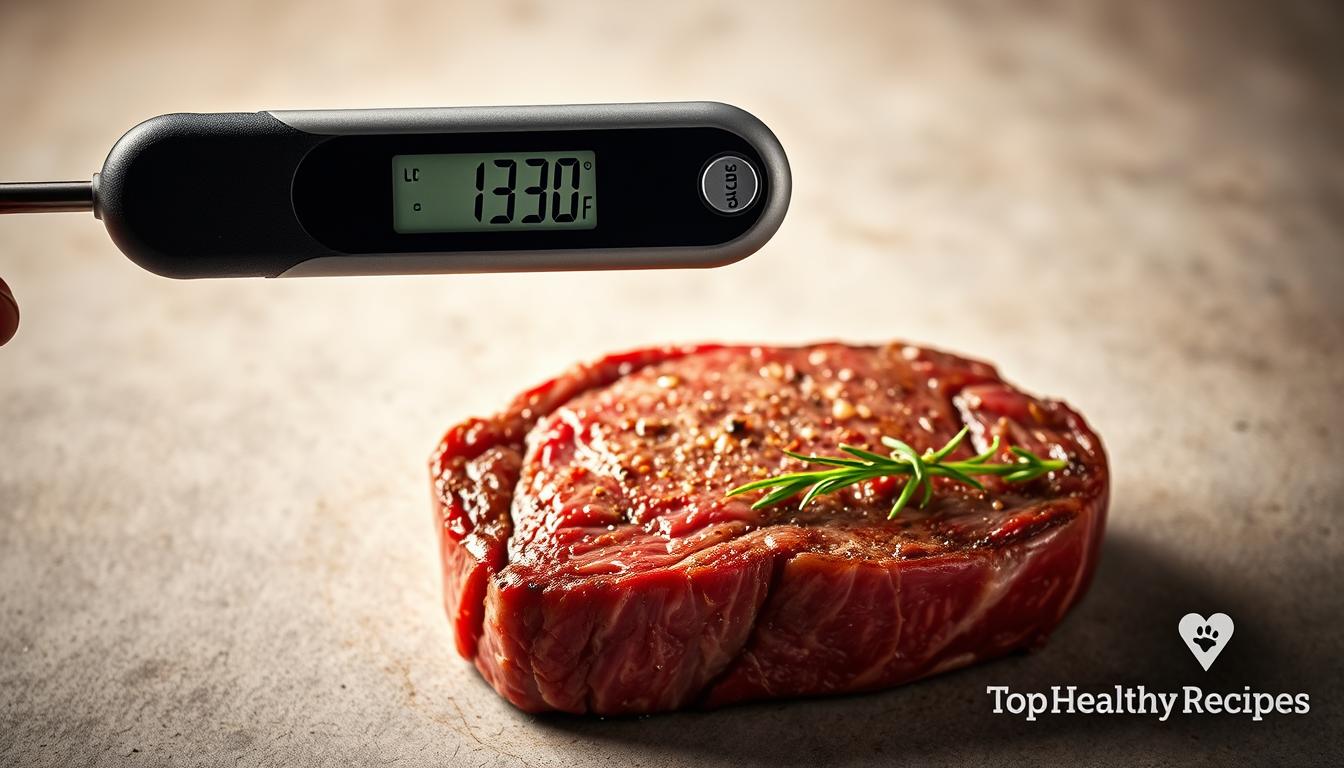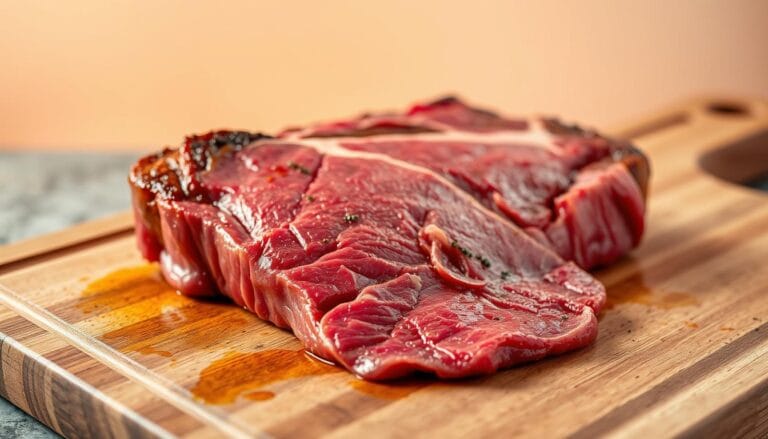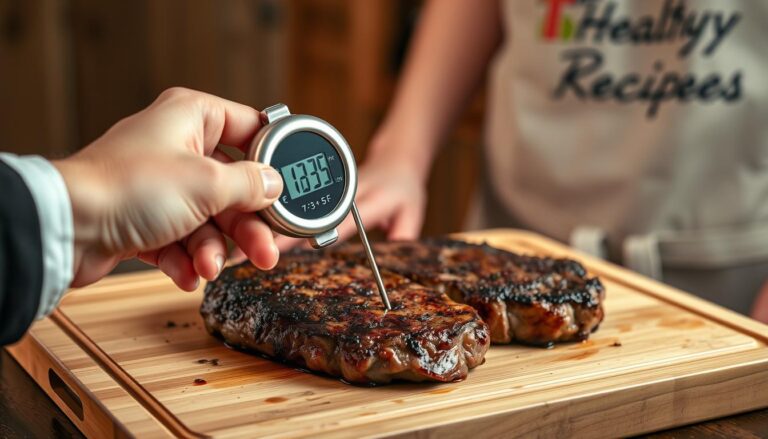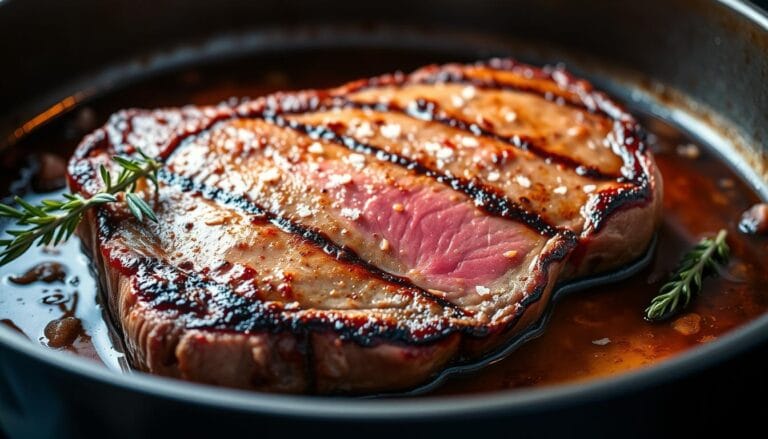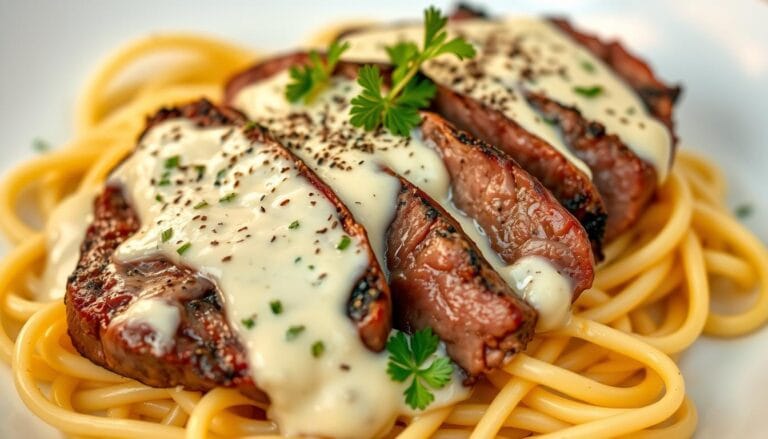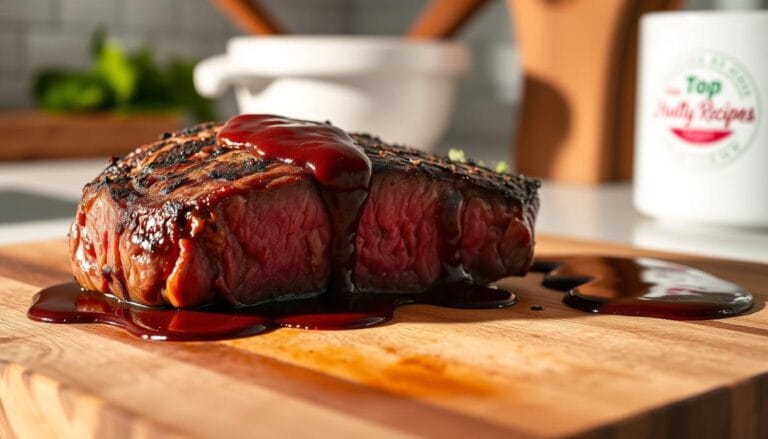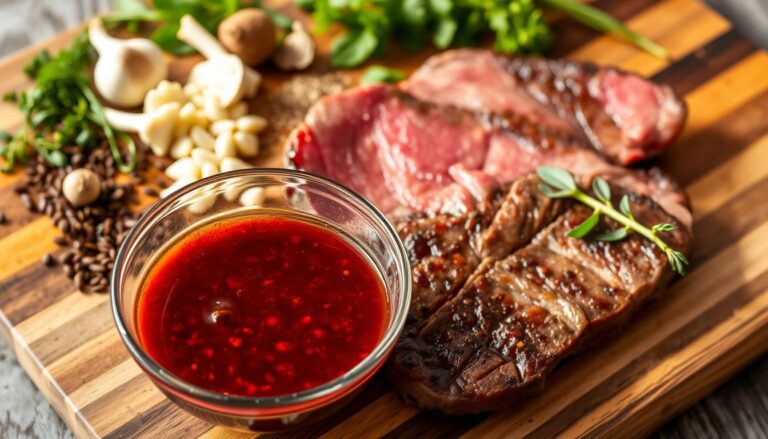What Temp Is a Medium Rare Steak? Find the Perfect Doneness Here
Table of Contents
What Temp Is a Medium Rare Steak? Find the Perfect Doneness Here
Cooking the perfect medium rare steak is an art that needs precision and a deep understanding of temperature control. When you hit that perfect balance, you get a pink center and a warm red middle. This makes for a truly exceptional dining experience.
For steak lovers, there’s nothing better than slicing into a perfectly cooked steak. Whether you’re new to cooking or have years of experience, knowing the ideal temperature for medium rare steak is key. It lets you create that restaurant-quality experience right in your own kitchen.
By knowing the exact temperature needed, you can make steaks that are both tasty and look great. This guide will show you the essential techniques and tools to get it just right.
Key Takeaways
- Understand the ideal temperature for a medium rare steak
- Learn techniques for achieving consistent results
- Discover the right tools for monitoring temperature accurately
- Explore tips for selecting the perfect cut of steak
- Elevate your cooking skills with expert advice
What Is Medium Rare Steak?
The medium rare steak is a favorite among chefs and foodies. It has a warm red center. This makes it tender and flavorful, a gold standard for steak lovers.
Definition of Medium Rare
Medium rare steak is defined by its internal temperature. It should be between 130°F and 135°F (54°C to 57°C). At this temperature, the steak stays juicy and tender.
To achieve a perfect medium rare, the steak should be cooked to an internal temperature that is warm red in the center. This ensures the proteins and fats in the meat react well. It enhances the dining experience.
Characteristics of Medium Rare Steak
A medium rare steak has a vibrant red-pink center and a seared brown exterior. It’s tender and juicy, easy to cut. The flavor is rich and beefy, showing off the natural qualities of the beef.
The characteristics of a medium rare steak can be summarized in the following table:
| Characteristics | Description |
|---|---|
| Internal Temperature | 130°F – 135°F (54°C – 57°C) |
| Center Color | Vibrant Red-Pink |
| Exterior Color | Seared Brown |
| Texture | Tender and Juicy |
| Flavor Profile | Rich and Beefy |
Why Choose Medium Rare?
Choosing to cook a steak medium rare is the best way to enjoy its full flavor and tenderness. It lets the natural qualities of the beef shine, enhanced by the cooking process. Steak connoisseurs love it for its melt-in-your-mouth experience.
Knowing what temperature is a medium rare steak is key to achieving this perfect balance. Cooking your steak to the correct internal temperature ensures a satisfying and enjoyable dining experience.
Importance of Steak Temperature
Learning about steak temperature can make you a better cook. Getting the internal temperature for medium rare steak right is more than just taste. It brings out the meat’s best flavors and textures.
Effects on Flavor
The way you cook your steak changes its taste. The Maillard reaction happens when you sear it. This reaction adds the flavors and smells we love in grilled or pan-seared steaks. Cooking it to the right temperature makes this reaction better, improving the taste.
Importance of Doneness Levels
Doneness levels, from rare to well-done, depend on the steak’s internal temperature. Medium rare is a hit because it’s juicy and flavorful. Knowing these levels lets you cook just how you like it, or how your guests prefer.
Cooking for Safety
Cooking steak to a safe temperature is vital for food safety. The USDA says to cook it to at least 145°F (63°C) for medium rare. Then, let it rest for three minutes. This ensures food safety while keeping your steak delicious.
Ideal Temperature for Medium Rare Steak
To cook a steak that’s truly medium rare, you need to know the exact internal temperature to aim for. The internal temperature is what defines the doneness of a steak. For medium rare, this temperature range is key.
Official Temperature Recommendations
The ideal internal temperature for medium rare steak is between 130°F to 135°F (54°C to 57°C). This range is accepted by culinary experts and the USDA. But, slight variations may exist based on personal preference and specific cooking guidelines.
Fahrenheit vs. Celsius
It’s important to understand temperature in both Fahrenheit and Celsius. This is because recipes often use different scales. The conversion between these two scales is straightforward. 130°F is equal to 54°C, and 135°F is equal to 57°C. Here’s a quick reference table for common temperature conversions:
| Fahrenheit (°F) | Celsius (°C) |
|---|---|
| 120 | 49 |
| 130 | 54 |
| 135 | 57 |
| 140 | 60 |
Tools to Measure Temperature
To achieve the perfect medium rare, you’ll need a reliable tool to measure the internal temperature of your steak. Here are some options:
- Instant-read digital thermometers: Quick and accurate, these are ideal for checking the temperature at the last minute of cooking.
- Wireless smart thermometers: These allow for continuous monitoring of the steak’s temperature without having to open the grill or oven.
- Traditional analog thermometers: Simple and often less expensive, these can be reliable but may lack the precision of digital models.
Choosing the right thermometer depends on your cooking style, budget, and personal preference.
Preparing Your Steak for Cooking
To cook a steak to the perfect medium rare, start by preparing it right. This means following a few key steps. These steps are important for getting the steak just right.
Selecting the Right Cut
The steak you pick can really affect how it turns out. For medium rare, choose cuts that are tender and have lots of marbling. These include ribeye, strip, filet mignon, and porterhouse steaks. Marbling is the fat inside the meat that makes it taste better and feel softer.
| Steak Cut | Marbling Level | Tenderness |
|---|---|---|
| Ribeye | High | Very Tender |
| Strip Steak | Medium | Tender |
| Filet Mignon | Low | Very Tender |
| Porterhouse | High | Very Tender |
Bringing Steak to Room Temperature
Letting your steak come to room temperature before cooking is key. It takes about 30-60 minutes. This helps the steak cook evenly, so you get a perfect medium rare in the middle.
Seasoning Techniques
How you season your steak can really change its taste. Some like it simple with just salt and pepper. Others prefer more complex rubs or marinades. It’s important to season at the right time to get the best flavor.
- Apply salt and pepper just before cooking for a classic flavor.
- Use a dry rub 30 minutes to 1 hour before cooking for added depth.
- Marinate your steak for several hours or overnight for intense flavor.
Cooking Methods for Medium Rare Steak
To cook a steak to medium rare perfection, several effective methods can be employed. The key to achieving a great medium rare steak lies not just in the technique, but also in understanding the nuances of each cooking method.
Grilling
Grilling is a popular method for cooking steak as it adds a smoky flavor and a nice char on the outside. To grill a steak to medium rare, it’s essential to use both direct and indirect heat zones. Preheat your grill to around 450-500°F, which is ideal for searing steaks. For steaks of different thicknesses, adjust your grilling time to ensure the internal temperature reaches the medium rare range.
Pan-Seering
Pan-searing is another effective way to cook a medium rare steak, when you can’t grill. Choose a cast iron pan for its heat retention. Use an oil with a high smoke point, like avocado oil, to prevent burning. Basting the steak with butter and aromatics during the last minute adds a rich flavor. Keep an eye on the internal temperature to achieve the perfect medium rare doneness.
Sous Vide
Cooking sous vide is a foolproof method for achieving a precise medium rare steak. This technique involves sealing the steak in a bag and cooking it in a water bath set to the exact medium rare temperature—typically between 130°F to 135°F for medium rare. After cooking, quickly sear the steak in a hot pan to add a crust. This method ensures a consistent temperature throughout the steak.
Understanding these cooking methods and their specific requirements will help you achieve a perfectly cooked medium rare steak. Whether you prefer grilling, pan-searing, or sous vide, the key is to monitor the internal temperature of the steak to ensure it reaches the desired doneness.
Using a Meat Thermometer
A meat thermometer is key to getting your steak just right for medium rare.
There are many types of meat thermometers out there. You can choose from instant-read digital thermometers, leave-in probe thermometers, wireless Bluetooth thermometers, and infrared surface thermometers. Each has its own benefits and fits different cooking styles.
Types of Meat Thermometers
Think about how you cook most often when picking a thermometer. Instant-read digital thermometers are perfect for quick checks. Leave-in probe thermometers let you watch the temperature all the time. Wireless Bluetooth thermometers let you check from afar, and infrared surface thermometers measure the steak’s surface.
- Instant-read digital thermometers: Quick and accurate, ideal for checking the internal temperature at the end of cooking.
- Leave-in probe thermometers: Allow for continuous temperature monitoring during cooking.
- Wireless Bluetooth thermometers: Enable remote monitoring through smartphone apps.
- Infrared surface thermometers: Measure the surface temperature of the steak.
How to Use a Meat Thermometer
Getting the right reading from a meat thermometer is important. To check your steak’s internal temperature, put the probe into the thickest part of the steak. Make sure it’s not near any bone or fat.
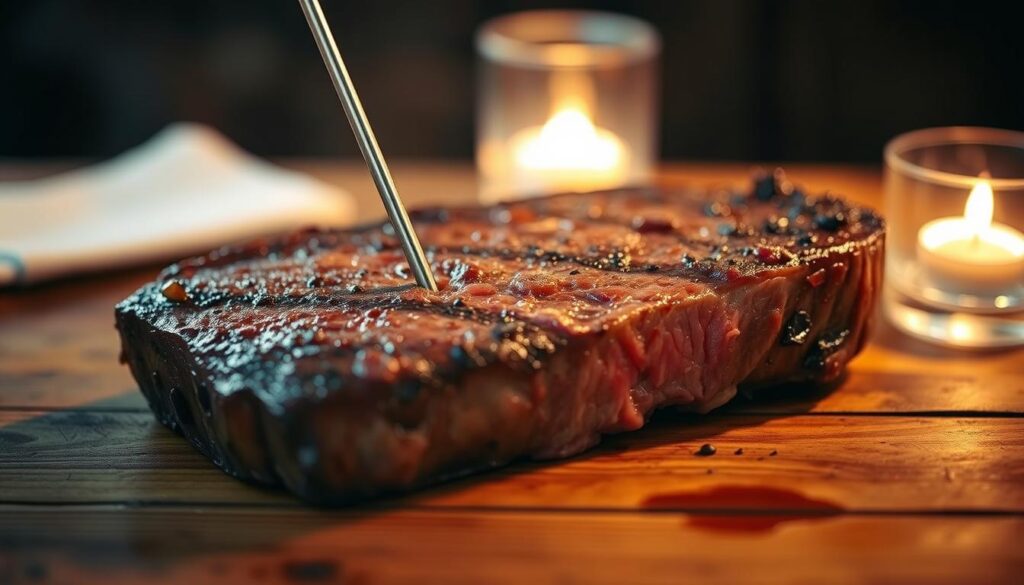
For steaks with bones, be careful not to touch the bone with the probe. This can give you a wrong reading. It’s also good to take a few readings to be sure. The perfect temperature for medium rare is between
Common Mistakes to Avoid
There are a few common mistakes to watch out for. Don’t check the temperature too soon or too often. This can let heat out of the steak. Also, make sure you’re placing the thermometer right, avoiding bones and the surface.
“The most common mistake people make when using a meat thermometer is not calibrating it properly before use.”
To avoid these mistakes, always calibrate your thermometer. Make sure to insert it correctly and check the temperature only when necessary.
It’s also important to take care of your thermometer. Clean it well and store it properly to keep it accurate over time.
Factors Affecting Cooking Time
To cook a steak to medium rare perfection, it’s key to know what affects cooking time. Several elements can change how fast your steak reaches the perfect medium rare temperature.
Thickness of the Steak
The thickness of your steak is very important for cooking time. Thicker steaks take longer to cook than thinner ones. For example, a 1-inch thick steak cooks faster than a 2-inch thick steak. Here’s a general guide for cooking times based on thickness:
- 1/2 inch thick steak: 2-4 minutes per side
- 1 inch thick steak: 4-6 minutes per side
- 1.5 inches thick steak: 6-8 minutes per side
- 2 inches thick steak: 8-10 minutes per side
Cooking Medium
The cooking medium, like a grill, pan, or oven, greatly affects cooking time. Different methods heat up at different rates. For instance, a preheated cast iron skillet sears the steak quickly. Oven cooking, on the other hand, provides even heat all around.
Starting Temperature
The initial temperature of your steak also matters a lot. Steaks straight from the fridge cook longer than those at room temperature. Letting your steak warm up to room temperature before cooking can make it cook faster and more evenly.
Here’s a simple chart to help plan your cooking. It considers steak thickness, cooking method, and starting temperature:
| Steak Thickness | Cooking Method | Starting Temperature | Cooking Time |
|---|---|---|---|
| 1 inch | Grilling | Room Temp | 4-6 minutes |
| 1.5 inches | Pan-searing | Cold | 8-10 minutes |
| 2 inches | Oven | Room Temp | 12-15 minutes |
Knowing these factors helps you estimate cooking times better. The goal is to cook your steak to the ideal medium rare temperature. This is between 130°F to 135°F (54°C to 57°C) for a perfect medium rare steak.
Resting Your Steak
Resting your steak is a key step many home cooks miss. It’s vital for the best flavor and texture. After cooking your steak to medium rare, let it rest.
The Importance of Resting
Resting lets the steak’s muscle fibers relax. This helps spread the juices evenly. If you cut into the steak right away, the juices spill out, making it dry.
By resting, you keep these juices inside. This makes each bite juicy and full of flavor.
Carryover Cooking: While resting, the steak’s internal temperature rises. This can add 5-10°F to the temperature. To get a perfect medium rare, remove it when it’s 5-10°F below your target, around 125°F.
How Long to Rest Your Steak
The resting time depends on the steak’s thickness. Thinner steaks need about 5 minutes, while thicker ones can rest up to 15 minutes. Finding the right time keeps your steak warm and juicy.
Slicing Techniques for Maximum Tenderness
After resting, slice your steak. Always cut against the grain for tenderness. Use a sharp knife to make clean cuts and keep the steak juicy.
Also, think about where you rest your steak. Foil can keep it warm, while open-air helps the crust. Your choice depends on what you prefer in your steak.
Enhancing Flavor After Cooking
To make your medium rare steak even better, think about adding flavors that match its taste. The right touches can make your meal more enjoyable, bite by bite.
Sauces and Marinades are key in adding flavor to your steak. Favorites like red wine reductions, béarnaise, and chimichurri go great with medium rare. Compound butters, with herbs and spices, melt over the steak, adding a rich taste.
Sauces and Marinades
There are many sauces and marinades to choose from. A red wine reduction adds a fruity taste, while béarnaise sauce brings creaminess. For a fresh taste, chimichurri is perfect. These not only add moisture but also boost your steak’s flavor.
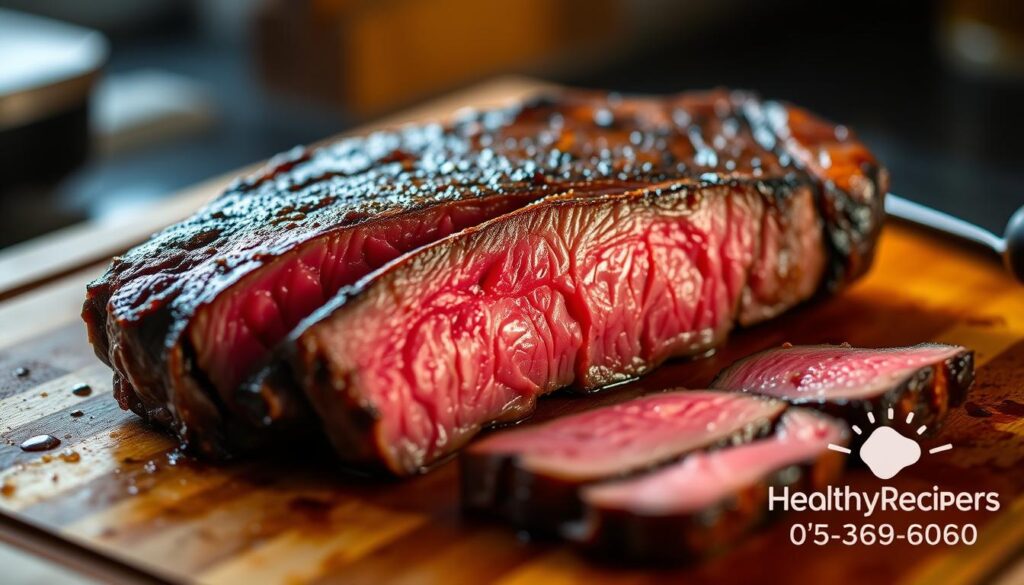
Herbs and Spices
The right herbs and spices can really bring out the beefy taste of your steak. Fresh herbs like rosemary and thyme add a nice aroma. Finishing salts like fleur de sel and smoked salt add a subtle saltiness. The goal is to enhance the steak’s flavor without overwhelming it.
Finishing Techniques
Professional chefs use special finishing techniques to add more flavor. Torch-finishing creates a caramelized crust, while butter-basting with aromatics adds more taste. It’s important to add delicate herbs carefully to avoid burning them.
By using these techniques, you can enrich your steak experience. You’ll enjoy the natural flavors of the steak, cooked to the perfect medium rare steak temperature.
Common Errors in Cooking Medium Rare
Cooking a medium rare steak needs focus and knowledge of common mistakes. To get the perfect medium rare steak temperature, between 130-135°F, knowing these errors is key.
One big challenge is not overcooking. This can happen for several reasons. These include not considering carryover cooking, using too much heat, and not adjusting cooking times for different steak sizes.
Overcooking Issues
Overcooking is a big problem when trying for a medium rare steak. To avoid it, keep these points in mind:
- Carryover cooking: The steak cooks a bit more after being taken off the heat.
- Heat control: Too high heat can quickly overcook the steak.
- Thickness variation: Thicker steaks need longer cooking times.
Understanding these points helps you control the cooking better. This way, you can get closer to the perfect medium rare temperature.
Under-seasoning Problems
Under-seasoning can really affect the taste of your steak. The right seasoning techniques, like when and how much salt to use, are key to bringing out the meat’s natural flavors.
Season your steak with salt right before cooking. Some chefs salt it ahead of time to let the salt penetrate. Use about 1/4 teaspoon of salt per pound of meat. This ensures your steak is not only cooked right but also full of flavor.
Misreading the Thermometer
A meat thermometer is essential for the perfect medium rare steak. But, reading it wrong can lead to steak that’s not done right.
Common mistakes include not putting the probe deep enough, touching bone, or reading the temperature wrong. To avoid these, make sure the probe is in the thickest part of the steak, away from bone or fat. Knowing how to use a thermometer correctly helps you know when your steak is at the perfect 130-135°F for medium rare.
Knowing these common errors and how to avoid them can greatly improve your steak cooking. Remember, the more you practice, the better you’ll get. Understanding the details of steak cooking will help you get consistent results.
Pairing Your Medium Rare Steak
After getting your steak to the perfect medium rare, think about what to serve with it. The right side dishes, wine, and sauces can make your meal even better.
Ideal Side Dishes
It’s important to pick side dishes that go well with your steak. Creamed spinach and roasted potatoes are great choices. But, you can also try grilled vegetables or mushroom risotto for something different.
Wine Pairings
Full-bodied red wines are perfect with medium rare steak. Cabernet Sauvignon, Malbec, and Syrah are top picks. Choose a wine that fits your budget, but splurge for special occasions. Craft beers, bourbon, and even non-alcoholic drinks like craft sodas can also be great.
“A great wine elevates the dining experience, complementing the complex flavors of a well-cooked steak.” –
Sauces and Condiments
The right sauce or condiment can make your steak even better. Horseradish and mustard are classics, but flavored aiolis and infused oils can also be great. The goal is to add flavor without covering up the steak’s taste.
- Horseradish sauce for a spicy kick
- Garlic butter for added richness
- Chimichurri for a fresh, herby flavor
Storing Leftover Steak
After enjoying your perfectly cooked medium rare steak, you might find yourself with leftovers. Proper storage is essential to maintain the quality and safety of the steak.
The first step in storing leftover steak is to cool it down to room temperature within two hours of cooking. This is critical for preventing bacterial growth. Once cooled, wrap the steak tightly in plastic wrap or aluminum foil, or place it in an airtight container.
Cooling and Wrapping Techniques
When it comes to wrapping your leftover steak, you have a few options. You can use plastic wrap, aluminum foil, or butcher paper. Each has its advantages. Plastic wrap provides a tight seal around the steak, preventing moisture from escaping. Aluminum foil offers additional protection against freezer burn if you plan to freeze the steak. Butcher paper, on the other hand, allows for some airflow, which can help prevent the buildup of condensation.
| Wrapping Material | Advantages | Disadvantages |
|---|---|---|
| Plastic Wrap | Tight seal, prevents moisture loss | May trap moisture, potentially leading to sogginess |
| Aluminum Foil | Protects against freezer burn, durable | Can react with acidic foods, not eco-friendly |
| Butcher Paper | Allows airflow, breathable | May not provide a tight seal, can be messy |
Reheating Options
Reheating your leftover steak requires care to maintain its medium rare temperature. You can reheat it using the oven, sous vide machine, or even serve it cold. For oven reheating, preheat to a low temperature (around 200°F), and warm the steak for about 10-15 minutes, or until it reaches your desired temperature. Sous vide reheating involves sealing the steak in a bag and placing it in a water bath at your desired temperature.
As noted by culinary experts, “Reheating steak using sous vide ensures that it retains its original texture and flavor.”
“The key to reheating steak is to do it gently, so you don’t overcook it further.” –
Safety Considerations
When storing and reheating leftover steak, safety is key. Always store it in the refrigerator at a temperature below 40°F. When reheating, make sure the steak reaches a minimum internal temperature of 165°F to ensure food safety. If you’re unsure whether the steak is safe to eat, look for signs of spoilage, such as an off smell or slimy texture.
To summarize, proper storage and reheating techniques are essential for enjoying your leftover medium rare steak while maintaining its quality and ensuring safety.
Frequently Asked Questions
Cooking steak to medium rare can raise several questions. These include temperature guidelines and the best cuts of meat. Here, we’ll address some of the most common queries to help you achieve steak perfection.
Steak Doneness Preferences
If you prefer your steak cooked to a different doneness level, understanding the internal temperatures for various levels can be helpful. The internal temperature for steak doneness levels are as follows:
| Doneness Level | Internal Temperature (°F) | Internal Temperature (°C) |
|---|---|---|
| Rare | 120-125 | 49-52 |
| Medium Rare | 130-135 | 54-57 |
| Medium | 140-145 | 60-63 |
| Medium Well | 150-155 | 66-68 |
| Well Done | 160+ | 71+ |
Using a meat thermometer is the most accurate way to determine the internal temperature of your steak. It ensures it reaches your desired level of doneness.
Cooking Medium Rare in the Oven
Yes, you can cook medium rare steak in the oven, using the reverse sear method. This involves cooking the steak at a low temperature in the oven first. Then, sear it in a hot pan.
“The reverse sear method allows for even cooking and can result in a perfectly cooked medium rare steak.” – Chef’s Guide
To use this method, preheat your oven to 200-250°F (90-120°C). Cook the steak to the desired internal temperature. Then, sear it in a hot pan with oil.
Best Cuts for Medium Rare
Certain steak cuts are more suitable for medium rare cooking than others. Cuts like ribeye, strip loin, and filet mignon are excellent choices. They offer a good balance of tenderness and flavor when cooked to medium rare.
On the other hand, tougher cuts like flank steak or brisket are better suited to different cooking methods. They are better cooked to a higher doneness level.
Additional FAQs cover topics such as cooking frozen steaks to medium rare. It’s possible with adjusted cooking times. They also discuss differences between bone-in and boneless cuts. Bone-in can affect cooking time.
By understanding these factors and techniques, you can master the art of cooking medium rare steak. You can achieve perfection, regardless of your preferences or dietary requirements.
Conclusion: Mastering Medium Rare Steak
To get the perfect medium rare steak, knowing the internal temperature is key. The ideal temperature is between 130°F to 135°F. A meat thermometer helps you get it just right.
Key Takeaways
Choosing the right cut and letting it come to room temperature are important. The thickness of the steak and how you cook it also matter. Letting it rest for 5-7 minutes after cooking makes it even better.
Practicing Steak Mastery
Getting good at cooking medium rare steak takes practice. Try different cooking times and seasonings to improve. For more tips and recipes, check out Top Healthy Recipes.
Final Tips
Mastering medium rare steak boosts your cooking skills and connects you to a rich tradition. Focus on the internal temperature and keep practicing. You’ll soon be making amazing meals.
FAQ
What is the internal temperature for a medium rare steak?
Can I cook a medium rare steak in the oven?
What cuts of steak are best for medium rare cooking?
How do I reheat leftover medium rare steak?
What are the most common errors when cooking medium rare steak?
What temperature is considered medium rare for steak?
Can I achieve medium rare with a frozen steak?
How long should I rest my steak after cooking?
What are some ideal side dishes to serve with medium rare steak?
How do I store leftover medium rare steak safely?
For more cooking tips, stay connected with us. We also recommend the cookbook Skinnytaste Simple: Easy, Healthy Recipes with 7 Ingredients or Fewer
For more Recipes about Steak ?
Did You try our recipe ?
There are no reviews yet. Be the first one to write one.
